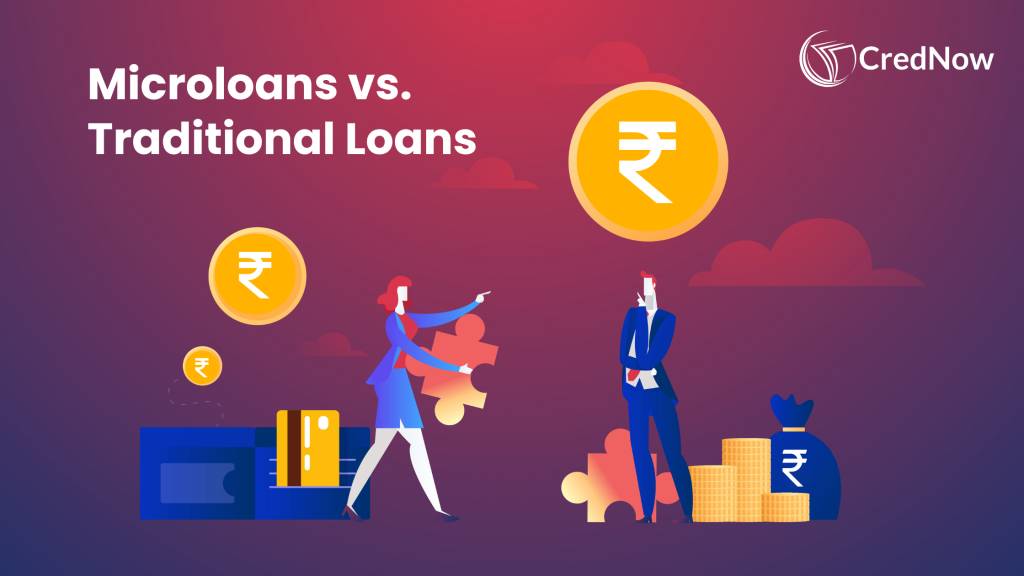Starting a new business in India is an exciting venture, but it often requires a significant amount of capital to get off the ground. For many entrepreneurs, securing funding is one of the biggest challenges they face. When it comes to financing your startup, you might find yourself weighing the options between microloans vs. traditional loans. Each has its own set of advantages and disadvantages, and choosing the right one can make a big difference in the success of your business. In this blog, we’ll explore the differences between microloans and traditional loans, helping you determine which option is best for your startup.
Understanding microloans
Microloans are small loans typically offered by microfinance institutions or non-profit organizations. These loans are designed to help small businesses and entrepreneurs who may not qualify for traditional bank loans. In India, microloans have gained popularity due to their accessibility, particularly for those in rural or underserved areas.
Key features of microloans:
- Smaller Loan Amounts: Microloans usually range from INR 5,000 to INR 1,00,000, making them ideal for startups with modest capital needs.
- Shorter Repayment Terms: The repayment period for microloans is typically shorter, often ranging from six months to two years.
- Flexible Eligibility Criteria: Microloans are often available to individuals with limited credit history or lower credit scores, making them accessible to a broader range of entrepreneurs.
- Higher Interest Rates: While microloans offer easier access to capital, they often come with higher interest rates compared to traditional loans.
Understanding traditional loans
Traditional loans, on the other hand, are offered by banks and other non-banking finance institutions. These loans are designed for businesses that need larger amounts of capital and can meet stricter eligibility criteria.
Key features of traditional loans:
- Larger Loan Amounts: Traditional loans can range from INR 1,00,000 to several crores, making them suitable for businesses with significant capital requirements.
- Longer Repayment Terms: The repayment period for traditional loans can extend from five to twenty years, providing businesses with more time to repay the loan.
- Stricter Eligibility Criteria: To qualify for a traditional loan, businesses usually need to have a solid credit history, collateral, and a detailed business plan.
- Lower Interest Rates: Traditional loans generally offer lower interest rates compared to microloans, especially for borrowers with good credit.
Microloans vs. traditional Loans: Which is right for your startup?
When deciding between microloans vs. traditional loans, it’s essential to consider your startup’s specific needs, your financial situation, and your long-term goals. Here’s a closer look at the factors you should weigh:
1. Loan Amount Required
- Microloans: If your startup requires a small amount of capital—say, to purchase equipment, cover initial inventory, or manage cash flow—microloans can be a great option. They provide quick access to funds without the need for extensive documentation or collateral.
- Traditional Loans: For startups that need substantial capital, such as those planning significant expansions or large-scale projects, traditional loans are more suitable. They offer larger loan amounts that can cover major expenses.
2. Ease of Access
- Microloans: One of the biggest advantages of microloans is their accessibility. They are designed to support small entrepreneurs who may not have a perfect credit score or sufficient collateral. This makes them an excellent choice for first-time business owners or those operating in rural areas.
- Traditional Loans: While traditional loans offer more money, they come with stricter eligibility criteria. If your startup has an established credit history, collateral, and a robust business plan, a traditional loan could be a better fit.
3. Repayment Terms
- Microloans: The shorter repayment terms of microloans can be both an advantage and a disadvantage. While it means you’ll pay off the debt quicker, it also requires you to manage your cash flow more tightly to meet the payments.
- Traditional Loans: The longer repayment periods of traditional loans provide more flexibility, allowing you to spread out the payments over several years. This can help reduce the pressure on your business’s cash flow in the early stages.
4. Interest Rates
- Microloans: Due to the higher risk associated with lending to startups with limited credit history, microloans typically come with higher interest rates. It’s important to calculate whether your business can handle the interest payments without compromising profitability.
- Traditional Loans: If you qualify for a traditional loan, you’ll likely benefit from lower interest rates. This can result in significant savings over the life of the loan, especially for larger loan amounts.
5. Purpose of the Loan
- Microloans: Microloans are ideal for specific, smaller-scale needs, such as purchasing equipment, funding a marketing campaign, or managing short-term working capital. They are less suited for large-scale projects or long-term investments.
- Traditional Loans: Traditional loans are versatile and can be used for a wide range of business purposes, from buying real estate to funding major expansions. If your startup has long-term financial goals that require significant investment, a traditional loan might be the better choice.
Recommended Read: The role of Micro Loans in supporting small businesses in India
Final thoughts: Making the right choice
Choosing between microloans vs. traditional loans depends on your startup’s unique circumstances. Microloans offer accessibility and speed, making them ideal for small, early-stage businesses that need quick funding and may not qualify for traditional financing. On the other hand, traditional loans provide more substantial funding with longer repayment terms and lower interest rates, which can be beneficial for established businesses with larger financial needs.
Before making a decision, carefully assess your startup’s financial situation, your ability to meet repayment terms, and how the loan will impact your business’s growth. Additionally, consider consulting with a financial advisor who can help you navigate the options and choose the best loan type for your startup’s success.
In the end, whether you opt for a microloan or a traditional loan, the key is to ensure that the loan aligns with your business goals and sets your startup on a path to growth and profitability. Understanding the pros and cons of microloans vs. traditional loans is the first step toward making an informed decision that will support your entrepreneurial journey in India.

FAQs
1. What is the main difference between microloans and traditional loans?
The main difference between microloans and traditional loans is the loan amount and eligibility criteria. Microloans offer smaller amounts (typically up to INR 1,00,000) with more flexible eligibility, while traditional loans provide larger sums (starting from INR 1,00,000 and going up to several crores) but require a stronger credit history and collateral.
2. Who should consider applying for a microloan?
Microloans are ideal for startups or small businesses that need a small amount of capital and may not have an extensive credit history or collateral. They are especially suitable for first-time entrepreneurs, businesses in rural areas, or those needing quick access to funds for specific, smaller-scale needs.
3. How do the interest rates of microloans compare to traditional loans?
Microloans typically have higher interest rates compared to traditional loans due to the increased risk associated with lending to new or small businesses. Traditional loans generally offer lower interest rates, especially for borrowers with good credit and strong collateral.
4. Can microloans be used for any business purpose, like traditional loans?
While microloans can be used for various business purposes, they are generally best suited for smaller-scale needs, such as purchasing equipment, managing cash flow, or funding a marketing campaign. Traditional loans, however, are more versatile and can be used for a wider range of purposes, including large-scale expansions and long-term investments.
5. What are the repayment terms like for microloans vs. traditional loans?
Microloans typically come with shorter repayment terms, usually between six months to two years, requiring quicker repayment. In contrast, traditional loans offer longer repayment periods, often ranging from five to twenty years, allowing for more flexibility in managing cash flow and payments over time.



